
by Laura Tiu | Mar 6, 2019
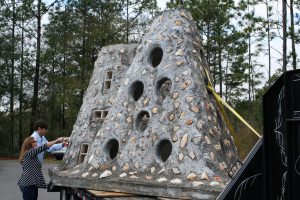
Artificial Reef Pyramid (Photo: L. Tiu)
The Northwest Florida Regional Artificial Reef Workshop was held February 20 at the Emerald Coast Convention Center in Fort Walton Beach Florida. It followed the Northwest Florida Regional Lionfish Workshop held the day before as many in the audience have interest in both lionfish and artificial reefs. Okaloosa County Commissioner, Captain Kelly Windes, gave the welcome, sharing his experiences as a lifelong local and a 3rd generation charter boat captain operating for over 30 years.
Keith Mille, Director of the Florida Fish and Wildlife Commission Artificial Reef Program gave the state updates. In the state of Florida, a total of 3,534 patch reefs have been deployed. In 2018, 187 new patch reefs were added to the mix. These reefs are made from concrete, formed modules, vessels, barges, metal and rock. The Atlantic side received 33 new patch reefs, while the Gulf side deployed 154. Many of the Gulf reefs are funded using Natural Resource Damage Assessment (NRDA) monies intended to compensate anglers and divers for loss of use during the 2010 Deepwater Horizon Oil Spill. According to a recent economic evaluation of artificial reefs by the University of West Florida’s Dr. Bill Huth, fishing and diving on Escambia County’s artificial reefs support 2,348 jobs and account for more than $150 million in economic activity each year.
County updates for Escambia, Santa Rosa, Okaloosa, Walton, Bay, City of Mexico Beach, Franklin, and Wakulla followed with Victor Blanco, Florida Sea Grant Agent from Taylor County, sharing his process for developing and training a volunteer research dive team to monitor the reefs.
University of Florida researchers provided a reef fish communities update highlighting the response of gray trigger fish and red snapper populations near the reefs, as well as the impact of lionfish on these communities. They also provided answers to the question of how artificial reefs function ecologically versus as fishing habitat. This research hopes to enhance future assessments concerning siting and function of artificial reefs. An anthropologist from Florida State University described his role in conducting cultural resource surveys for artificial reefs. The day ended with a report on the assessment of artificial reefs impacted by Hurricane Michael and a demonstration of updated software used to create side scan mosaics for monitoring.
Presentations were recorded and are available on the Florida Artificial Reefs Facebook page. A statewide Artificial Reef Summit is being organized for February 2020 and will be a great opportunity to learn more about Florida reefs.
“An Equal Opportunity Institution”
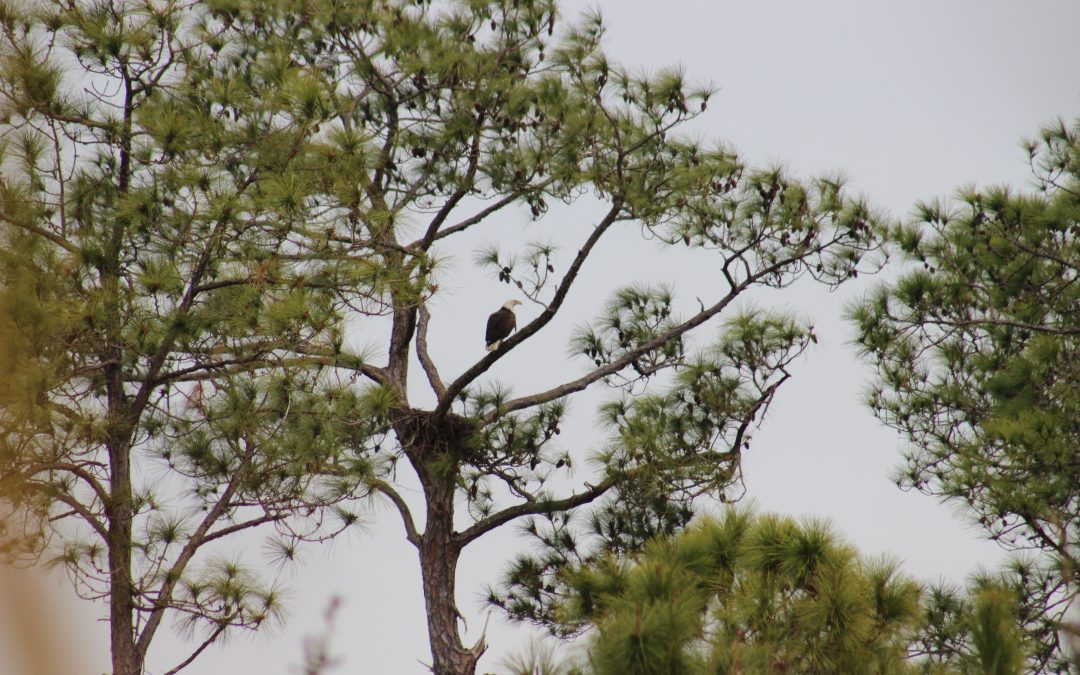
by Rick O'Connor | Feb 10, 2019
On a recent trip to Santa Rosa Island, my wife saw two bald eagles flying down the shore of Santa Rosa Sound. Wanting photos of the nest, we searched and found two individuals in a small nest (for an eagle) in a tall pine. One individual was an adult, the other a juvenile.
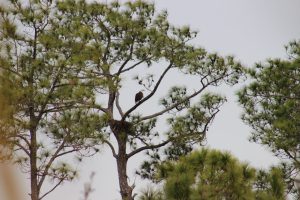
Bald eagle nest on Santa Rosa Island.
Photo: Molly O’Connor
Seeing bald eagles is like seeing bottlenose dolphins. I do not care how many times you have seen them over the course of your life, it is always exciting. Growing up here, I do not remember these animals in our area. Of course, their numbers suffered greatly during the DDT period, and poaching was (and still can be) a problem. But both the banning of DDT and the listing on the Endangered Species List did wonders for this majestic bird. They now estimate over 250,000 breeding populations in North America and 88% of those within the United States. Florida has some of the highest densities of nests in the lower 48 states. Though the bird is no longer listed as an endangered species, it is still protected by the Florida Eagle Rule, the federal Migratory Bird Treaty, and the federal Bald and Golden Eagle Protection Act.
It was shortly after Hurricane Ivan that someone told me they had seen a bald eagle in the area. My first reaction was “yea… right… bald eagle”. Then one afternoon on my back porch, my wife and I glanced up to see two flying over. Now we see them every year. The 2016 state report had 12 nesting pairs in the Pensacola Bay area. They were in the Perdido Bay area, Escambia Bay area, Holly-Navarre area, and Pensacola Beach area. Many locals now see these birds flying over our coastlines searching for food and nesting materials on a regular basis.
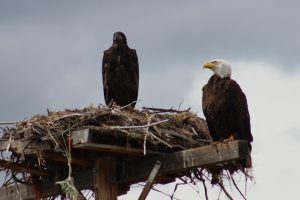
An adult and juvenile bald eagle on nest in Montana.
Photo: Molly O’Connor
Bald eagles are raptors with a thing for fish. However, they are opportunistic hunters feeding on amphibians, reptiles, crabs, small mammals, and other birds. They are also notorious “raiders” stealing fish from osprey, other raptors, and even mammals. They are also known scavengers feeding on carrion and visiting dumps looking for scraps. Benjamin Franklin was in favor of the turkey for our national emblem because the bald eagle was of such low moral character – referring their stealing and scavenging habit.
The Cornell Lab of Ornithology list the bald eagle as a year-round resident along the Gulf coast, but most of us see them in the cooler months. Their nesting period is from October through May. They select tall trees near water and build their nest just below the crown of the canopy. One local ecotourism operator has noticed their preference for live trees over the dead ones selected by osprey. Eagle nest are huge. A typical one will be 5-6 feet in diameter and 2-4 feet tall. The record was a nest found in St. Pete FL that was 10 feet in diameter and over 20 feet tall! The inside of the nest is lined with lichen, small sticks, and down feathers. One to three eggs are typically laid each season, and these take about 35 days to hatch. Both parents participate in nest building and raising of the young.
Viewing bald eagles is amazing, but approaching nests with eggs, or hatchlings, can be stressful for the parents. Hikers and motorized vehicles should stay 330 feet from the nests when viewing. Bring a distance lens for photos and be mindful of your presence.
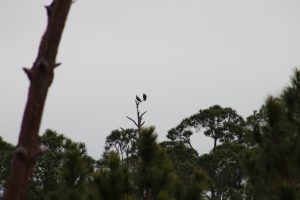
An adult and juvenile bald eagle are perched in a dead tree near their nest.
Photo: Molly O’Connor
No matter how times you see these birds, it is still amazing. Enjoy them.
References
Florida Fish and Wildlife Conservation Commission. Bald Eagle Management. 2018. https://myfwc.com/wildlifehabitats/wildlife/bald-eagle/.
Jimbo Meador, personal communication. 2017.
Williams, K. 2017. All About Birds, the Bald Eagle. Cornell University Lab of Ornithology. https://www.allaboutbirds.org/guide/Bald_Eagle/overview.
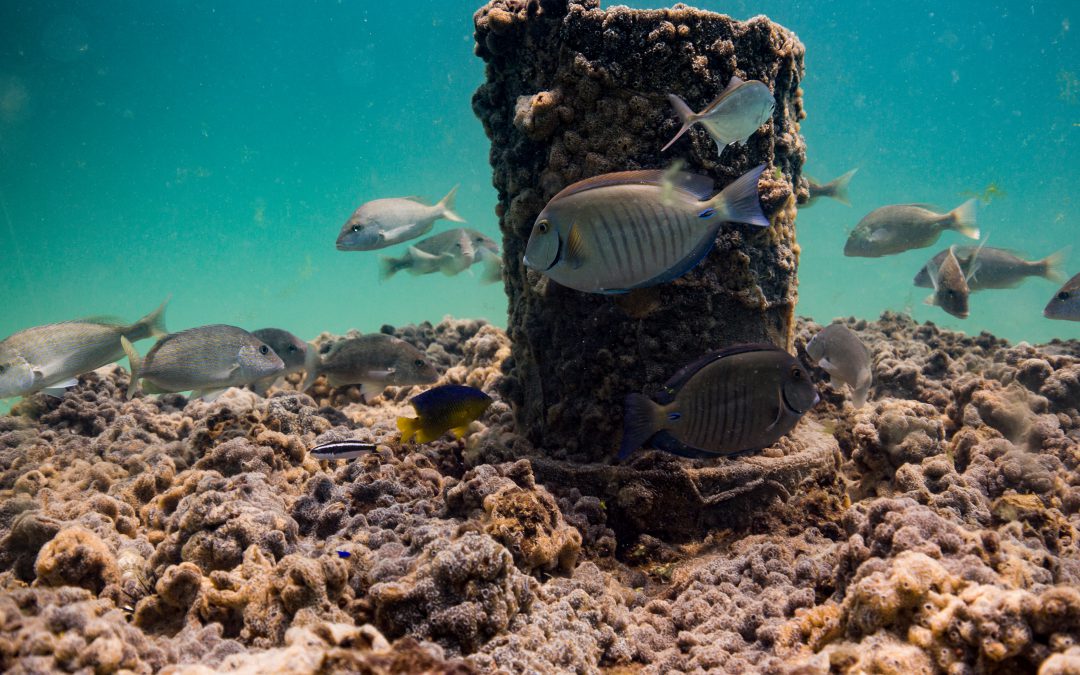
by Laura Tiu | Jan 31, 2019
They say that dreams don’t work unless you take action. In the case of some Walton County Florida dreamers, their actions have transpired into the first Underwater Museum of Art (UMA) installation in the United States. In 2017, the Cultural Arts Alliance of Walton County (CAA) and South Walton Artificial Reef Association (SWARA) partnered to solicit sculpture designs for permanent exhibit in a one-acre patch of sand approximately .7-miles from the shore of Grayton Beach State Park at a depth of 50-60 feet. The Museum gained immediate notoriety and has recently named by TIME Magazine as one of 100 “World’s Greatest Places.” It has also been featured in online and print publications including National Geographic, Lonely Planet, Travel & Leisure, Newsweek, The New York Times, and more.
Seven designs were selected for the initial installation in summer of 2018 including: “Propeller in Motion” by Marek Anthony, “Self Portrait” by Justin Gaffrey, “The Grayt Pineapple” by Rachel Herring, “JYC’s Dream” by Kevin Reilly in collaboration with students from South Walton Montessori School, “SWARA Skull” by Vince Tatum, “Concrete Rope Reef Spheres” by Evelyn Tickle, and “Anamorphous Octopus” by Allison Wickey. Proposals for a second installation in the summer of 2019 are currently being evaluated.
The sculptures themselves are important not only for their artistic value, but also serve as a boon to eco-tourism in the area. While too deep for snorkeling, except perhaps on the clearest of days, the UMA is easily accessible by SCUBA divers. The sculptures are set in concrete and contain no plastics or toxic materials. They are specifically designed to become living reefs, attracting encrusting sea life like corals, sponges and oysters as well large numbers and varieties of fish, turtles and dolphins. This fulfills SWARA’s mission of “creating marine habitat and expanding fishery populations while providing enhanced creative, cultural, economic and educational opportunities for the benefit, education and enjoyment of residents, students and visitors in South Walton.”
The UMA is a diver’s dream and is in close proximity to other Walton County artificial reefs. There are currently four near-shore snorkel reefs available for snorkeling and nine reefs within one mile of the shore in approximately 50-60 feet of water for additional SCUBA opportunities. All reefs are public and free of charge for all visitors with coordinates available on the SWARA website (https://swarareefs.org/). Several SCUBA businesses in the area offer excursions to UMA and the other reefs of Walton County.
For more information, please visit the UMA website at https://umafl.org/ or connect via social media at https://www.facebook.com/umaflorida/.

Schools of fish swim by the turtle reef off of Grayton Beach, Florida. Photo credit: University of Florida / Bernard Brzezinski
by Les Harrison | Jan 4, 2019
Florida’s park system has many unique and quality experiences to offer visitors, but few stand out as much as The Edward Ball Wakulla Springs State Park. It is home of the world’s largest and deepest freshwater springs.
The brisk water is home to manatees, alligators and a host of diverse wildlife which can be viewed from the shore or a boat. Each season delivers a different selection of birds passing through and offering birdwatchers a prime destination to see the avian residents and visitors in a natural setting.
The bracing, some say chilly, 70 degree waters are sure to refresh bathers even during the hottest summer days. For some human visitors ankle deep is enough to experience.
Wakulla Springs’ history extends back thousands of years with evidence of varied use by people and animals, some long gone. Early residents lived in shoreline villages and took advantage of the plentiful natural resources to support their idyllic existence.
One novel use of the area was by filmmakers who appreciated the primeval quality of the park’s swamps and wildlife as a backdrop for cinematic productions. Hollywood films such as Tarzan’s Secret Treasure (1941) and Creature from the Black Lagoon (1954) were shot at this location.
The historic lodge is an elegant remnant of old Florida, and set among the ancient cypress trees which surround the swamps. The Spanish style lodge with its period furniture, original elevators and colorful painted ceilings that depicts wildlife and Old Florida scenes still takes lodgers.
For the adventurous, there are several hiking trails requiring varying degrees of exertion. For more information about the park’s amenities visit their website: https://www.floridastateparks.org/parks-and-trails/edward-ball-wakulla-springs-state-park
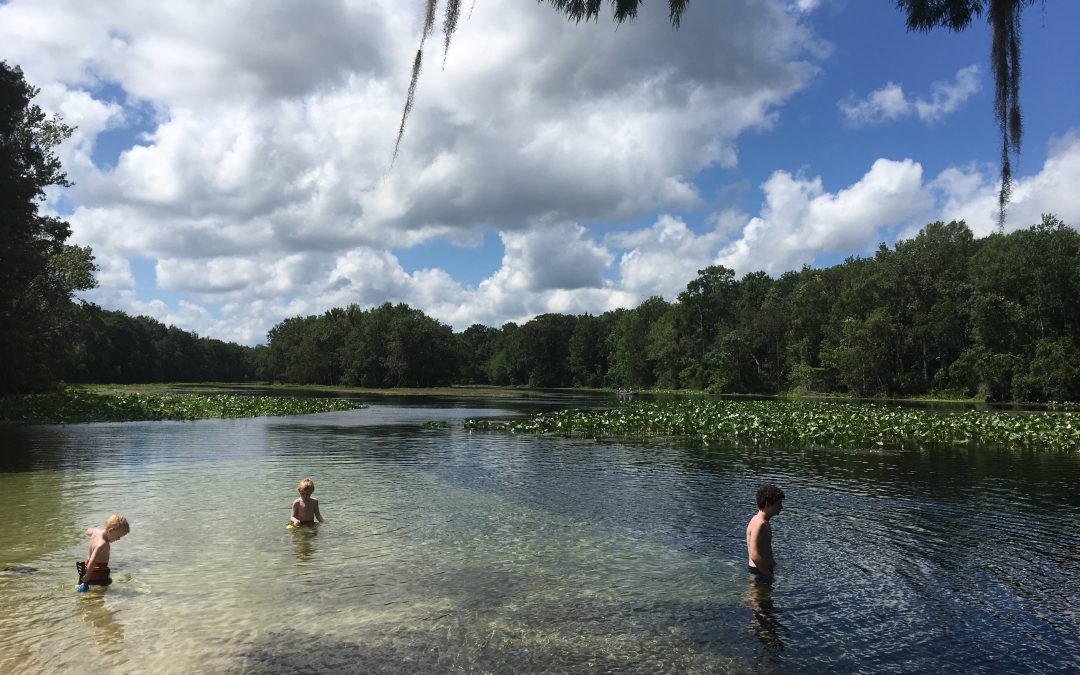
by Les Harrison | Sep 28, 2018
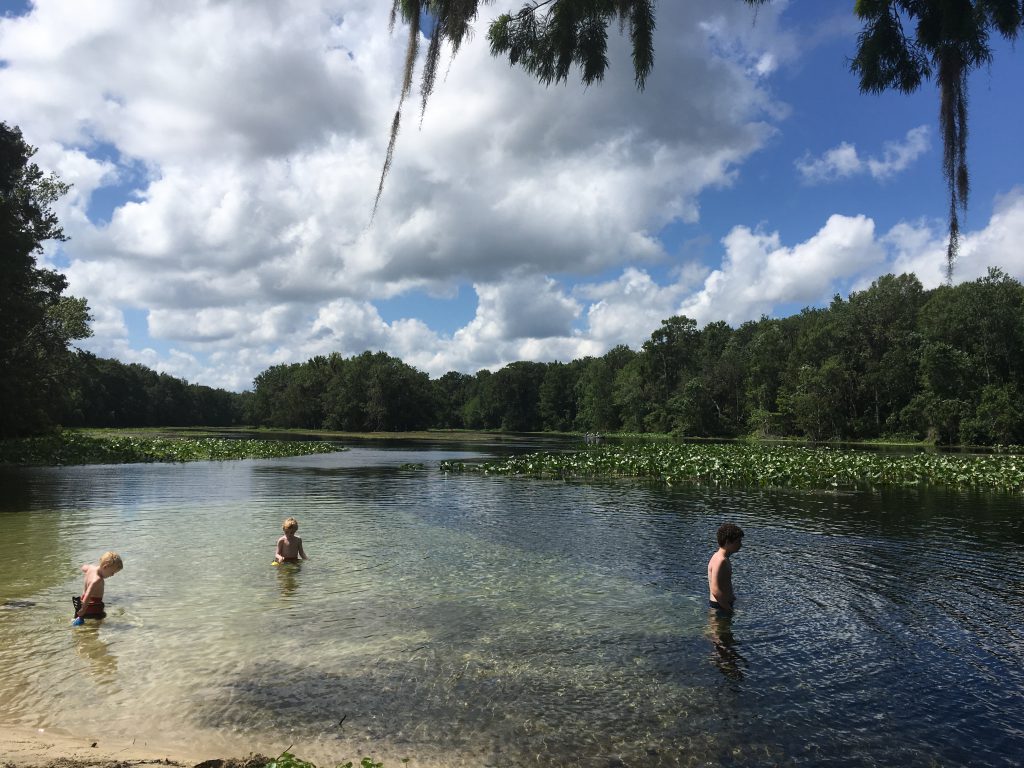
The Wacissa River offers paddlers the opportunity to see north Florida unfiltered.
Being off the beaten path has many advantages. In the case of a spring-fed river, it translates to less pressure from human use and a great opportunity for those who do visit to experience the “real Florida”.
The Wacissa River, located in the southern half of Jefferson County, Florida, is near the crossroads identified as the town of Wacissa. There is a blinking light, a post office, and two small convenience stores where beer, ice and snacks can be purchased.
Access to the river is about two miles south of the blinking light on Florida 59, just after the state road veers to the southwest. The blacktop spur quickly become a dirt parking lot after passing several canoe and kayak rental businesses.
A county maintained boat landing with pick-nic tables, a manmade beach, and a tiny diving platform with a rope swing are the only signs of civilization. The cold, clear water extends to a tree line several hundred yards south of the landing with the river moving to the southeast.
The river emerges crystal clear from multiple limestone springs along the first mile and a half of the 12 mile waterway. The adjacent land is flat and subject to being swampy, especially in wet years like 2018.
The river terrain stands in contrast to the Cody Scarp just a few miles to the north. This geologic feature is the remnants of an ancient marine terrace and is hilly, rising 100 feet above the river in some spots.
Cypress, oak, pine, and other trees cover the bottomlands adjacent to the river. The river quickly enters the Aucilla Wildlife Management Area which results in a wide variety of animals, birds, amphibians and reptiles.
The wildlife viewing varies by season. Many migratory birds use the river’s shelter and resources on their annual trips.
Canoeing and kayaking are popular in the gentle current. Powerboats and fan boats can use the area also, but must be on constant alert for shallow spots and hidden snags.
For the adventurous paddler who wants to follow the river’s course, there is a debarkation point at Goose Pasture Campgrounds and another near St. Marks after the Wacissa merges with the Aucilla.
Be prepared when taking this journey. This is the real Florida, no fast food restaurants or convenience stores. Only clear water, big trees and the calls of birds will be found here.
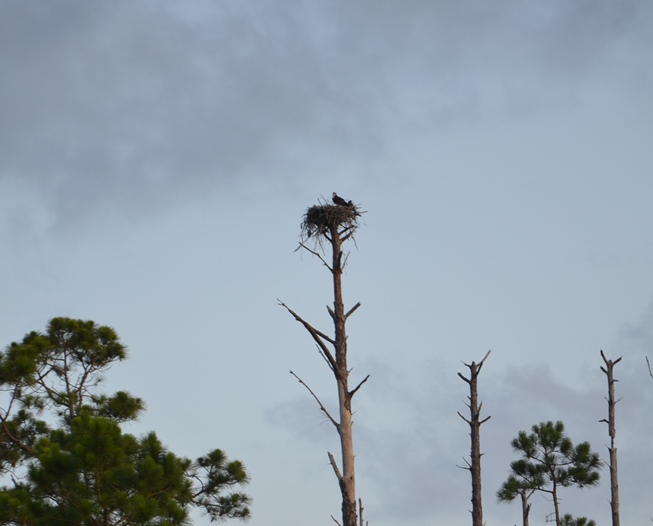
by Rick O'Connor | Aug 17, 2018
As a kid growing up here along the Gulf Coast, I had never heard of an osprey. Now, there is at least one mating pair on almost every body of water in the Pensacola Bay area. Where did this once unknown bird come from? How has it successfully colonized our coastal waterways?
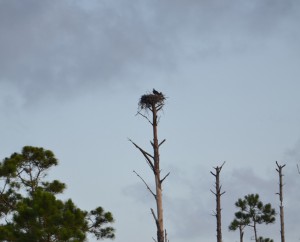
Osprey nesting sites are commonly near water, and their food source.
The osprey, like many other fish eating birds, was a victim of the DDT story. This miracle pesticide was developed to battle insects attacking food crops but was found to be useful against mosquitos and many other unwanted pests. It was sprayed everywhere using planes, trucks, and tractors. With an extremely long half-life, wherever it landed it was going to be around for a while – it can still be found in the sediments of the Pensacola Bay System. It was one of those compounds that was difficult to excrete through an organisms excretory system – thus it accumulated within their tissues, and as organisms fed on other organisms, it was passed up the food chain – bioaccumulation. Birds of prey who fed on fish would accumulate DDT as well. It caused the shells of their eggs to become thinner – so nesting was not successful – and many of the aquatic birds of prey (pelicans and eagles alike) declined in number. DDT was banned in 1970s and many of these fish eating birds have made a remarkable recovery – a true success story.
So who is this fish eating bird of prey that can be found on dead trees and light posts all over the bay area?
Ospreys (Pandion haliaetus) are members of the family Accipitridae – the hawks and eagles.
They are predators with hooked bills and sharp talons to grab and dispose of prey. Ospreys can be identified by the hawk like silhouette hovering over a local waterway searching for fish – their primary food. They are usually in pairs and, at times, the young are hovering nearby. Their call is a high pitch chirping sound and if seen on a tree, or on their nest, they are brown on top and white beneath. These birds are common along both fresh and saltwater bodies of water.
Ospreys prefer waterways where fish are plentiful. For more successful hunting, they like waters that are relatively shallow and nesting locations that protect the young from mammalian predators. Many local osprey prefer large dead trees for their nests, and will often use manmade structures – such as power poles, navigation markers, and special platforms on poles placed there for the purpose of osprey nesting.
Osprey feed almost exclusively on fish. They are unique in the hawk world in that their talons can adjust so that the captured fish can be turned parallel to the osprey’s body – making it more aerodynamic when returning to the nest. Hunting osprey hover over the water searching and then dive, talons first into the water. They can only reach depths of about three feet so they typically hunt for surface schooling fish, or in shallow waters. Most of their captures are between 8-10 inches and include such fish as speckled trout, mullet, and catfish.
These birds are monogamous (mating pairs breed for life). During the breeding season, the male will collect sticks for the construction of their large nests. Bringing them back to the female, she will begin to arrange and construct the nest. The male provides seagrass and flotsam for the inner lining. There is a pre-courtship dance where the returning male flies over the nest with a fish. The pair produce between 3-4 eggs. Both parents will incubate the eggs but the female does the lions share. She will incubate while the male hunts. Returning with a fish for her, she will fly to a nearby branch to feed while he incubates the eggs – though they have seen the males incubate even without feeding the female. Evening incubation is always the female.
After hatching, the male will bring food to both the female and young. She does not leave the young at all for about 14 days. Afterwards, they will be left alone for periods of time, and are usually fledged by 50 days. Data shows that young fledglings rarely disperse more than 30 miles from the nest they hatched from – suggesting slow dispersal of this species. The mating pair will return to the same location for nesting every year for up to 30 years.
There are few predators of osprey due to their nesting habits. In some locations, where they nest on the ground, coyotes have been a problem. Locally, bald eagles are known to try to grab hatchlings and, occasionally, adults. There have been reports of crocodiles taking adults from the water in South Africa; this may be the case in South America as well, but no reports of American Alligators doing the same.
This is now a common bird along our shores and is a true conservation success story.
References
National Audubon Society Field Guide to North American Birds; Eastern Region. Ed. J. Bull, J. Farrand Jr. pp. 795.
Osprey. Neotropical Birds. Cornell Lab of Ornithology. https://neotropical.birds.cornell.edu/Species-Account/nb/species/osprey/overview.












